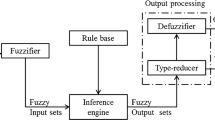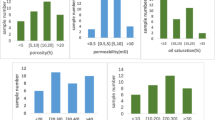Abstract
The selection of refracturing candidate is one of the most important jobs faced by oilfield engineers. However, due to the complicated multi-parameter relationships and their comprehensive influence, the selection of refracturing candidate is often very difficult. In this paper, a novel approach combining data analysis techniques and fuzzy clustering was proposed to select refracturing candidate. First, the analysis techniques were used to quantitatively calculate the weight coefficient and determine the key factors. Then, the idealized refracturing well was established by considering the main factors. Fuzzy clustering was applied to evaluate refracturing potential. Finally, reservoirs numerical simulation was used to further evaluate reservoirs energy and material basis of the optimum refracturing candidates. The hybrid method has been successfully applied to a tight oil reservoir in China. The average steady production was 15.8 t/d after refracturing treatment, increasing significantly compared with previous status. The research results can guide the development of tight oil and gas reservoirs effectively.
摘要
重复压裂选井是油藏工程师面临的一项重要的工作. 然而, 影响重复压裂选井的因素众多, 且关系复杂, 在不同程度上影响重复压裂效果, 使得重复压裂选井十分困难. 本文提出了一种新的结合数据分析技术和模糊聚类的重复压裂井混合方法. 首先, 利用数据分析技术计算不同影响因素的权重因子, 明确影响压裂效果的关键因素. 其次, 提出了新的理想重复压裂井概念, 利用模糊聚类方法评价候选井重复压裂潜力, 并结合油藏数值模拟方法进一步评价最优重复压裂井的地层能量和物质基础. 该混合方法成功地应用于中国致密油气藏重复压裂选井, 实现了候选井重复潜力等级划分与优先排序. 单井重复压裂后生产效果大幅度提高, 稳定日产油量 15.8 t. 研究成果对致密油气藏高效开发有重要指导作用.
Similar content being viewed by others
References
RUI Zhen-hua, CUI Ke-hang, WANG Xiao-qing, LU Jun. A quantitative framework for evaluating unconventional well development [J]. Journal of Petroleum Science & Engineering, 2018, 166: 900–905.
GUO Ling, JIA Chao-chao, DU Wei. Geochemistry of lower Silurian shale of Longmaxi Formation, southeastern Sichuan Basin, China: Implications for provenance and source weathering [J]. Journal of Central South University, 2016, 23(3): 669–676.
JAVAHERI A, DEHGHANPOUR H, WOOD J M. Tight rock wettability and its relationship to other petrophysical properties: A montney case study [J]. Journal of Earth Science, 2017, 28(2): 381–390. (in Chinese)
CHONG Zhao-hui, LI Xue-hua, CHEN Xiang-yu. Numerical investigation into the effect of natural fracture density on hydraulic fracture network propagation [J]. Energies, 2017, 10(7): 914–947.
WANG Shen, LI Hua-min, LI Dong-yin. Numerical simulation of hydraulic fracture propagation in coal seams with discontinuous natural fracture networks [J]. Processes, 2018, 6(8): 113–138.
BHATTACHARYAS S, NIKOLAOU M. Comprehensive optimization methodology for stimulation design of low-permeability unconventional gas reservoirs [J]. SPE Journal, 2016, 21: 947–964.
LIU Jia, WANG Jian-guo, LEUNG Chun-cai, GAO Feng. A multi-parameter optimization model for the evaluation of shale gas recovery enhancement [J]. Energies, 2018, 11(3): 1–29.
ZENG Jie, WANG Xiang-zeng, GUO Jian-chun, ZENG Fan-hua. Composite linear flow model for multi-fractured horizontal wells in tight sand reservoirs with threshold pressure gradient [J]. Journal of Petroleum Science & Engineering, 2018, 165: 890–912.
DU Jin-hu, LIU He, MA De-sheng. Discussion on effective development techniques for continental tight oil in China [J]. Petroleum Exploration & Development, 2014, 41(2): 217–224.
ZHAO Yu-long, ZHANG Lie-hui, ZHOU Yu-hui, LIU Qi-guo. Pressure response and production performance for multi-fractured horizontal wells with complex seepage mechanism in box-shaped shale gas reservoir [J]. Journal of Natural Gas Science & Engineering, 2016, 32: 66–80.
TAO Liang, GUO Jian-chun, ZHOU Xiaofeng, ALENA K, ZENG Jie. A new productivity prediction hybrid model for multi-fractured horizontal wells in tight oil reservoirs [C]//SPE Russian Petroleum Technology Conference. Society of Petroleum Engineers, Moscow, Russia, 2018: SPE-191714.
CHONG Zhao-hui, LI Xue-hua, CHEN Xiang-yu, ZHANG Ji. Numerical investigation into the effect of natural fracture density on hydraulic fracture network propagation [J]. Energies, 2017, 10(7): 914–947.
GUO Jian-chun, WANG Jian-dong, LIU Yu-xuan, CHEN Zhang-xin. Analytical analysis of fracture conductivity for sparse distribution of proppant packs [J]. Journal of Geophysics & Engineering, 2017, 14(3): 599–610.
FENG Qi-hong, XIA Tian, WANG-SEN, SINGH H. Pressure transient behavior of horizontal well with time-dependent fracture conductivity in tight oil reservoirs [J]. Geofluids, 2017, 12: 1–19.
HOU Teng-fei, ZHANG Shi-chen, MA Xin-fang, SHAO Jun-jie. Experimental and theoretical study of fracture conductivity with heterogeneous proppant placement [J]. Journal of Natural Gas Science & Engineering, 2016, 37: 449–461.
ZANFANEH B, CLARKSON C, HAWKES R. Reinterpretation of fracture closure dynamics during diagnostic fracture injection tests [C]// SPE Western Regional Meeting. Bakersfield, California, 2017: SPE-185649-MS.
HE You-wei, CHEN Shi-qing, QIN Jia-zheng, CHAI Zhi, WANG Ping. Analytical interference testing analysis of multi-segment horizontal well [J]. Journal of Petroleum Science & Engineering, 2018, 171: 919–927.
GUO Jian-chun, TAO Liang, ZENG Fan-hui. Optimization of refracturing opportunity for horizontal well in tight oil reservoirs: A case study of cretaceous Qingshankou formation in the Songliao Basin, NE China [J]. Petroleum Exploration and Development, 2019, 46(1): 1–6.
JACOBS T. Renewing mature shale wells through refracturing [J]. Journal of Petroleum Technology, 2014, 66(4): 52–60.
SHAH M, SHAH S, SIRCAR A. A comprehensive overview on recent developments in refracturing technique for shale gas reservoirs [J]. Journal of Natural Gas Science & Engineering, 2017, 46: 350–364.
FRENCH S, RODGERSON J, FEIK C. Re-fracturing horizontal shale wells: Case history of a Woodford shale pilot project [C]// SPE Hydraulic Fracturing Technology Conference. The Woodlands, Texas, USA, 2014: SPE-168607-MS.
GRIESER B, CALVIN J, DULIN J. Lessons learned: refracs from 1980 to present [C]// SPE Hydraulic Fracturing Technology Conference. The Woodlands, Texas, USA, 2016: SPE-179152.
LINDSAY G, WHITE D, MILLER G. Understanding the applicability and economic viability of refracturing horizontal wells in unconventional plays [C]// SPE Hydraulic Fracturing Technology Conference. The Woodlands, Texas, USA, 2016: SPE-179113.
VINCENT M. Refracs: Why do they work, and why do they fail in 100 published field studies? [C]// SPE Annual Technical Conference and Exhibition. Florence, Italy, 2010, SPE-134330.
UDEGBE E, MORGAN E, SRINIVASAN S. From face detection to fractured reservoir characterization: Big data analytics for restimulation candidate selection [C]// SPE Annual Technical Conference and Exhibition. San Antonio, Texas, USA, 2017: SPE-187328-MS.
ROUSSEL N P, SHAEMA M M. Selecting candidate wells for refracturing using production data [J]. SPE Production & Operations, 2013, 28(1): 36–45.
REEVES S R, BASRIAN P A, SPIVEY J P. Benchmarking of restimulation candidate selection techniques in layered, tight gas sand formations using reservoir simulation [C]//SPE Annual Technical Conference and Exhibition. Dallas, Texas. 2000: SPE-63096-MS.
WANG Yang-fang, SALEHI S. Refracture candidate selection using hybrid simulation with neural network and data analysis techniques [J]. Journal of Petroleum Science and Engineering, 2014, 123: 138–146.
TAVASSOLI S, WEI Y, JAVADPOUR F, SEPEHRNOORI K. Selection of candidate horizontal wells and determination of the optimal time of refracturing in Barnett Shale [C]// SPE Unconventional Resources Conference. Alberta, Canada, 2013: SPE-167137.
ISHIZAKA A, LABIB A. Review of the main developments in the analytic hierarchy process [J]. Expert Systems with Applications, 2011, 38(11): 14336–14345.
ZENG Fan-hui, CHENG Xiao-zhao, GUO Jian-chun, TAO Liang. Hybridising human judgment, AHP, grey theory, and fuzzy expert systems for candidate well selection in fractured reservoirs [J]. Energies, 2017, 10(4): 447–469.
XIAO Yong, GUO Jian-chun, HE Song-gen. A Comparison study of utilizing optimization algorithms and fuzzy logic for candidate-well selection [C]// SPE/IATMI Asia Pacifc Oil & Gas Conference & Exhibition. Nusa Dua, Bali, Indonesia, 2015: SPE-187328-MS.
DENG Jing-long. Control problems of grey systems [J]. Systems & Control Letters, 1982, 1(5): 288–294.
ASLAN N. Use of the grey analysis to determine optimal oil agglomeration with multiple performance characteristics [J]. Fuel, 2013, 109(7): 373–378.
RUI Zhen-hua, LU Jun, ZHANG Zhi-en, GUO Rui. A quantitative oil and gas reservoir evaluation system for development [J]. Journal of Natural Gas Science & Engineering, 2017, 42: 31–39.
FANG J H, CHEN H C. Fuzzy modelling and the prediction of porosity and permeability from the compositional and textural attributes of sandstone [J]. Journal of Petroleum Geology, 2010, 20(2): 185–204.
MASOUDI P, AIFA T, MEMARIAN H, TOKHMECHI B. Uncertainty assessment of volumes of investigation to enhance the vertical resolution of well-logs [J]. Journal of Petroleum Science & Engineering, 2017, 154: 252–276.
WEI M, SUNG A, CATHER M. Mining spatially abnormal data in spatial databases [C]// Canadian International Petroleum Conference. Calgary, Alberta, 2004: PETSOC-2004-42.
Author information
Authors and Affiliations
Corresponding author
Additional information
Foundation item: Projects(51204054, 51504203) supported by the National Natural Science Foundation of China; Project(2016ZX05023-001) supported by the National Science and Technology Major Project of China
Rights and permissions
About this article
Cite this article
Tao, L., Guo, Jc., Zhao, Zh. et al. Refracturing candidate selection for MFHWs in tight oil and gas reservoirs using hybrid method with data analysis techniques and fuzzy clustering. J. Cent. South Univ. 27, 277–287 (2020). https://doi.org/10.1007/s11771-020-4295-0
Received:
Accepted:
Published:
Issue Date:
DOI: https://doi.org/10.1007/s11771-020-4295-0
Key words
- tight oil and gas reservoirs
- idealized refracturing well
- fuzzy clustering
- refracturing potential
- hybrid method




